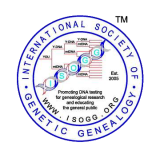DNA reconstruction
From ISOGG Wiki
in genetic genealogy, DNA reconstruction most commonly refers to mathematically creating an autosomal DNA kit representing a deceased individual.
DNA Reconstruction Terminology
DNA resources as either "mono" or "stereo." A mono kit only contains data from one copy of any chromosome at any given position. Mono kits are not necessarily phased in the traditional sense, as they may contain segments from both the paternal and maternal copies, but rather are phased at the block or segment level. In contrast, a stereo kit contains data comprising of at least one overlapping paternal and maternal block or segment. Factory DNA kits from the major testing companies are stereo kits, as they contain overlapping paternal and maternal blocks and segments throughout.
DNA resources are also categorized as either "full" or "partial" based on reconstruction coverage.of the autosomal and X-chromosomes. A factory DNA kit exhibits 100% coverage and is considered a full stereo resource. Traditionally phased kits (phasing using a parent and child) exhibit 50% coverage and are considered full mono resources. Partially reconstructed resources such as output from the GEDmatch Lazarus tool would be considered partial resources.
"Resolution" of a reconstructed DNA resource (or element thereof) is the percentage of SNPs in the output of a reconstruction process (not comprised of no call values), relative to count of SNPs reported in a factory kit used as input.
The descendants of a target of reconstruction are divided into "sibling clades." Each sibling clade consists of genetic descendants of a single child of the reconstruction target. Donors within a sibling clade are referred to as contributors to that clade. Contributors to a reconstruction workflow can be in-clade or cross-clade depending on whether they all are members of a single sibling clade with respect to the target of reconstruction. Reconstructions using solely in-clade donors always result in mono output, where reconstructions that rely upon cross-clade contributors typically result in stereo output. The distinction is crucial for designing workflows using multiple tools.
DNA Reconstruction Tools
- The Borland Genetics Web Tools and Database is a database linked to a suite of tools designed specifically to assist users in reconstructing their ancestors.
- The Lazarus tool at GEDmatch allows users to select multiple DNA kits and place them into three categories (Group 1: descendants of the reconstruction target, Group 2: relatives of the target related to the members of group 1 only via the target, and Group 0: the target's spouse and his or her relatives).
